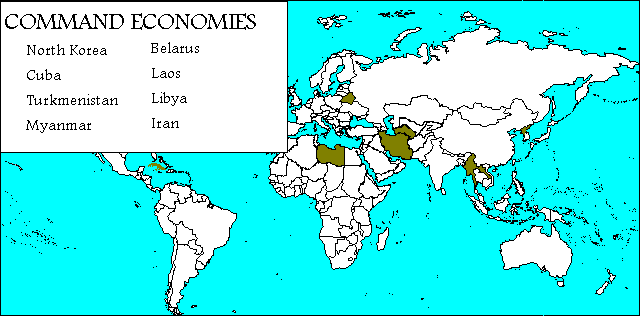A. The Market and the 5Es
1. Economic Growth
a. Define
b. Economic Growth and the characteristics of Capitalism
(1) private property
(2) self interest
(3) freedom of enterprise and choice
c. market economies tend to have faster growth rates
than do command economies
2. Allocative Efficiency: Producing what consumers
want
a. The role of self interest in
capitalism provides INCENTIVES to be allocatively
efficient.
- more profits = produce more
- losses = produce less
b. Capitalism's use of the market (supply and demand -
Ch. 3) provides a MEANS to achieve allocative
efficiency
- consumer sovereignty and "dollar votes"
c. Capitalism tends to achieves allocative
efficiency
3. Productive Efficiency: Producing at a minimum
cost
a. The role of self interest in
capitalism provides INCENTIVES to be productively
efficient.
(1) profits = total revenues - total cost
(2) minimizing costs means more profits
(3) minimizing costs is productive efficiency
b. Capitalism tends to achieve productive
efficiency
4. Equity
- Capitalism does not have a mechanism to assure
EQUITY. This may be a role of government (ch. 5)
5. Full Employment
- Economists disagree over whether capitalism will
guarantee FULL EMPLOYMENT.
- studied in macroeconomics
B. Summary:
1. The move toward capitalism has resulted in high
rates of ECONOMIC GROWTH in many countries. Profits, private
property, and freedom of enterprise and choice promote
growth
2. The price mechanism (supply and demand) and the role
of self interest provides for an ALLOCATIVELY EFFICIENT use of
resources
3. Capitalism provides the incentives (profit) for a
PRODUCTIVELY EFFICIENT use of resources
4. Capitalism does not have a mechanism to assure
EQUITY. This may be a role of government
5. Economists disagree over whether capitalism will
guarantee FULL EMPLOYMENT.
- Some say yes, and if there is unemployment it is
usually caused by government interference
- Some say no, and at times government involvement is
needed to move the economy towards full employment
A. Introduction
1. The five fundamental questions must be answered
by all economic systems.
2. The five fundamental questions are:
a. What goods and services will to be
produced?
b. How will the goods and services be produced?
c. Who will get the output?
d. How will the system accommodate change?
e. How will the system promote progress?
B. What will be produced? (Allocative
Efficiency)
1. In order to be profitable, businesses must
respond to consumers' (individuals, other businesses, and the
government) wants and desires.
2. Consumer Sovereignty and "dollar votes"
C. How will the goods and services be produced? (Productive
Efficiency)
1. The market system encourages and rewards those
producers who are achieving least-cost production.
2. The most productively efficient technique will be the
one that produces a given amount of output with the smallest
input of limited resources.
D. Who will get the output? (Equity)
1. determined by how the income is distributed
2. Products go to those who are willing and able to pay
for them.
3. The productivity of the resources, the relative supply
of particular resources, and the ownership of the resources
will determine the income of individuals and
households.
4. The resulting distribution of income may not be the
most equitable (fair).
E. How will the system accommodate change?
1. Markets are dynamic - what is efficient today
may not be efficient tomorrow as tastes, technology, and
resource supplies change.
2. Prices help signal those changes and the market will
respond. This guiding function of prices is essential to a
well-functioning market system.
3. In the absence of such signals, government or some
similar institution would have to decide where resources are
allocated, but without knowing what people in society want. the
result would most likely be allocatively inefficient.
F. How will the system promote progress?
1. The market system promotes technological
improvements and capital accumulation (economic growth).
2. An entrepreneur or firm that introduces a popular new
product will be rewarded with increased revenue and profits.
(allocative efficiency)
3. New technologies that reduce production costs, and
thus product price, will spread throughout the industry as a
result of competition. (economic growth)
4. Creative destruction occurs when new products and
production methods destroy the market positions of firms that
are not able or willing to adjust. NOTE: this is good for
society.



